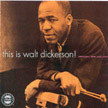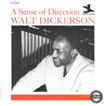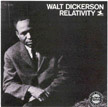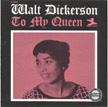| |
Walt Dickerson : A Promise Postponed
by Derek Taylor
March 2000
Like any rich tradition, jazz lore is brimming with anecdote and fable.
Stories behind the music are often as fascinating as the sounds themselves.
One such archetype that seems to be repeated time and again is that
of the jazz musician who soldiers on in the face of public and critical
indifference or hostility until finally and inexorably succumbing
to the pressures and disappearing from the landscape. This cycle of
attrition seems particularly prevalent among musicians who gravitate
toward freer forms of improvisation, as the biographies of Dolphy,
Ayler, and a host of others seem to bear out. While Walt Dickerson
doesn't completely fit into this framework there are aspects of his
career that sadly mirror the symptoms. After a prodigious beginning
at the dawn of the 1960s with a quartet of albums for the forward-thinking
Prestige subsidiary label New Jazz and except for a flourish of activity
during the 70s, Dickerson's recorded legacy remains a checkered enterprise.
The reasons behind his continued evanescence remain a mystery, but
his absence is made all the more regrettable when one delves into
the beautiful string of dates he recorded in his youth.
Before Dickerson's initial ascent approaches to the vibraphone in
jazz were dominated by the popular rubrics of Lionel Hampton and Milt
Jackson, both of whom forged their techniques out of a highly structured
melodic invention. The only recorded precursor to Dickerson's unique
style seems to be Earl Griffith, an exciting postmodernist player
who recorded a single date with Cecil Taylor and then promptly dropped
out of sight (see Taylor's Looking Ahead on the Contemporary label).
Bobby Hutcherson, who would again revolutionize the instrument over
the course of his work for Blue Note, was still several years away
from making his entrance. The absence of competition made the playing
field ripe for Dickerson's brilliant debut.
Dickerson's methodology on his instrument was largely unprecedented.
Several aspects of his style and approach described in the original
liner notes to his first recording for New Jazz contributed to his
atypical sound. Rather than employing felt mallets like his peers
Dickerson preferred rubber ones. In addition he chose to grip his
sticks much closer to the heads and made only sparing use of the vibraphone's
motor. Each of these eccentricities resulted in far less vibrato and
sustain and a more metallic sound in his playing. Armed with these
signature attributes he set about taking his adopted home of New York
City by storm. This Is Walt Dickerson! emphatically announced
his arrival.
 Dickerson
brought with him two players from his native Philadelphia for this
inaugural date, Austin Crowe and Bob Lewis. Andrew Cyrille, who would
later join the ranks of Cecil Taylor's various units, rounded out
the promising quartet. Boldly opting for a program comprised solely
of his own compositions, Dickerson diligently set about making history.
"Time" is a relaxed, almost drowsy opening, but Dickerson's loquacious
solo that centers the piece is brimming with quietly communicated
ideas. Crowe's playing is frequently the flipside of his darkly dulcet
malletwork. "Elizabeth" moves the group into tender ballad territory
as Dickerson and Crowe saunter along atop conciliatory brushes and
throbbing bass. Clever rhythmic stops and starts playfully keep the
players on their toes on "The Cry", the disc's most intricately conceived
piece on a structural level. Cyrille's drums are the paragon of polyrhythmic
ingenuity in complete communion with Lewis' pulsing bass vamp. "Death
and Taxes" works off a repeated bass line signifying the certainty
of the elements of the title. Dickerson and Crowe solo beautifully
against this symbolic monotony devising creative statements that directly
contradict the supremacy of life's constraining constants. "Evelyn"
is saturated in a mood of leisurely motion thanks mainly to Dickerson's
luminous lines and the coils of rhythmic coloring that unravel from
Cyrille's brushes. "Infinite You" serves as a fitting summation of
this groundbreaking album and points the way to the future with an
assured finger. The piece finds Dickerson at his most outwardly vociferous
and features one of Crowe's most cogent solos. Dickerson
brought with him two players from his native Philadelphia for this
inaugural date, Austin Crowe and Bob Lewis. Andrew Cyrille, who would
later join the ranks of Cecil Taylor's various units, rounded out
the promising quartet. Boldly opting for a program comprised solely
of his own compositions, Dickerson diligently set about making history.
"Time" is a relaxed, almost drowsy opening, but Dickerson's loquacious
solo that centers the piece is brimming with quietly communicated
ideas. Crowe's playing is frequently the flipside of his darkly dulcet
malletwork. "Elizabeth" moves the group into tender ballad territory
as Dickerson and Crowe saunter along atop conciliatory brushes and
throbbing bass. Clever rhythmic stops and starts playfully keep the
players on their toes on "The Cry", the disc's most intricately conceived
piece on a structural level. Cyrille's drums are the paragon of polyrhythmic
ingenuity in complete communion with Lewis' pulsing bass vamp. "Death
and Taxes" works off a repeated bass line signifying the certainty
of the elements of the title. Dickerson and Crowe solo beautifully
against this symbolic monotony devising creative statements that directly
contradict the supremacy of life's constraining constants. "Evelyn"
is saturated in a mood of leisurely motion thanks mainly to Dickerson's
luminous lines and the coils of rhythmic coloring that unravel from
Cyrille's brushes. "Infinite You" serves as a fitting summation of
this groundbreaking album and points the way to the future with an
assured finger. The piece finds Dickerson at his most outwardly vociferous
and features one of Crowe's most cogent solos.
 Recorded
three months later, A Sense of Direction finds Crowe as the
only returning sideman. The quartet is completed by two of Dickerson's
long-standing associates, though the sleeve notes erroneously confuse
the instruments of Edgar Bateman and Eustis Guillemet, Jr. Three standards
creep into the repertoire and the overarching impressions are much
more lyrical on this sophomore effort. Bateman's drums are less overtly
expressive than Cyrille's but he still keeps agile time and works
in creative fills. Recorded
three months later, A Sense of Direction finds Crowe as the
only returning sideman. The quartet is completed by two of Dickerson's
long-standing associates, though the sleeve notes erroneously confuse
the instruments of Edgar Bateman and Eustis Guillemet, Jr. Three standards
creep into the repertoire and the overarching impressions are much
more lyrical on this sophomore effort. Bateman's drums are less overtly
expressive than Cyrille's but he still keeps agile time and works
in creative fills.
The beginning title piece benefits from a linear immediacy that reflects
the players' confidence. "Ode to Boy" is a gradual ballad piece dedicated
to Dickerson's deceased brother that spreads in temperate waves, but
terminates in a wash of doleful melancholy. Switching gears again
Dickerson and Crowe engage in a complimentary dialogue of separate
lines during the brisk frolic of "Togetherness" which sets a sagacious
stage for the euphonious reading of "What's New". "Good Earth" works
from an oscillating waltz structure and Dickerson's wordless vocal
accompaniment to his melodic improvisations are particularly audible
and enthusiastic. "Why" is inquisitive both in name and design, but
suffers some from Bateman's lock-step rhythmic accompaniment. The
quartet takes their sweet time on "You Go To My Head" massaging the
familiar melody with genial hands and in the process constructing
an edifice of enduring beauty. Dickerson's elongated solo here opens
the ideal aperture into his creative process. Over its course he investigates
an astonishing array of thematic variants. The disc closes with an
arrangement of "If I Should Lose You" built around a subtle Bossa
beat that benefits significantly from Bateman's light stick work and
frequent accents on the rims of his cymbals and snares. Crowe's contributions
are also instrumental to the easy allure of the piece and make it
a fitting finale.
 Jump
ahead seven months to the inception of 1962. Dickerson's reappearance
at the Van Gelder Studios to record Relativity was an auspicious
one in the company of his strongest group to date. Cyrille's return
to the fold marked an even more advanced rhythmic sense than he demonstrated
on Dickerson's debut. Malik's earlier tenure with Monk at the Five
Spot made him an infallible choice to round out the rhythm section.
This third recording also marks Dickerson's full-fledged embrace of
the restless experimental side of his character that fueled his earliest
session. Jump
ahead seven months to the inception of 1962. Dickerson's reappearance
at the Van Gelder Studios to record Relativity was an auspicious
one in the company of his strongest group to date. Cyrille's return
to the fold marked an even more advanced rhythmic sense than he demonstrated
on Dickerson's debut. Malik's earlier tenure with Monk at the Five
Spot made him an infallible choice to round out the rhythm section.
This third recording also marks Dickerson's full-fledged embrace of
the restless experimental side of his character that fueled his earliest
session.
Cyrille's drums initiate the title piece at a modest, but undulating
pace before his free form cymbal accents push the group forward in
a surge of momentum. Malik's busy walking bass quickens the tempo
while Dickerson and Crowe make full use of the expansive rhythmic
undercurrent to build intuitive solos. Cyrille's brief, but bold turn
echoes the direction he would take his drums during his term as sideman
with Cecil Taylor. An adventurous rendition of "It Ain't Necessarily
So" swiftly becomes a feature for Dickerson's adroit mallets though
Malik has a fleeting opening to spotlight the tensile strength of
his fingers in a superlative solo of his own. Placid timbres prevail
on "I Can't Get Started" making the piece a fitting follow-up to the
energized precocity of the earlier numbers. The reverie is short-lived
however. Dickerson's "Steppin' Out" is an accelerated tour-de-force
that rockets along under the power of Cyrille's rapid-fire rimshots.
"Unknown" presents something altogether different again. An ominous
duet between Dickerson and Malik, it is easily the most dissonant
piece on the disc. The pair's querulous conversation becomes a study
in contrasts. Malik makes striking use of his bow whether cleaving
off dense craggy lines or bouncing it percussively against his strings
while Dickerson's vibes set up a vaporous tonal backdrop for his improvisations.
Perhaps in an effort to temper the seriousness of the piece, the proceeding
"Sugar Lump" celebrates the youthful swagger and confidence that each
of players seems to gain artistic sustenance from. As an epilogue
the quartet's version of "Autumn in New York" ties up the loose ends
of the disc in a luxurious exposition of balladic prowess.
 Nine
months later Dickerson returned once again to the studio. In the interim
between dates Down Beat had seen fit to award him as a 'New Star'
on his vibraphone in their 1962 critics poll. On the occasion of his
fourth recording session he was to document what many of those familiar
with his work consider to be his magnum opus To My Queen, which
included a dedicatory suite to his wife Elizabeth that effectively
encapsulates his approach and resolve on his instrument. In attendance
for this seminal outing is a trio of sidemen of a caliber that Dickerson
would not recreate for the remainder of his career. Andrew Hill was
over a year away from his legendary stay at Blue Note, but the emancipating
imagination that characterized his work with that label is already
on display here. Cyrille again holds down the drum duties and testifies
to his continuing aspiration toward rhythmic liberation. George Tucker's
presence as anchor is perhaps the most important and his voice on
strings is a unifying element, particularly on the title piece. Nine
months later Dickerson returned once again to the studio. In the interim
between dates Down Beat had seen fit to award him as a 'New Star'
on his vibraphone in their 1962 critics poll. On the occasion of his
fourth recording session he was to document what many of those familiar
with his work consider to be his magnum opus To My Queen, which
included a dedicatory suite to his wife Elizabeth that effectively
encapsulates his approach and resolve on his instrument. In attendance
for this seminal outing is a trio of sidemen of a caliber that Dickerson
would not recreate for the remainder of his career. Andrew Hill was
over a year away from his legendary stay at Blue Note, but the emancipating
imagination that characterized his work with that label is already
on display here. Cyrille again holds down the drum duties and testifies
to his continuing aspiration toward rhythmic liberation. George Tucker's
presence as anchor is perhaps the most important and his voice on
strings is a unifying element, particularly on the title piece.
In listening to "To My Queen" it's easy to become lost in the piece's
persisting flow of imagery. Dickerson sits out for almost half of
its duration and Hill and Tucker are both afforded a liberal amount
of space to solo. Attention can be directed toward the contributions
of each of the players, but the suite seems to work on a deeper level
than these individual parts. The feeling conveyed by the composition
is one of heart-felt and lasting love, which surpasses the musical
structures that form its foundation. The rendition of "How Deep Is
the Ocean" is similarly protracted and in this standard setting the
solos of the players are invested with less interdependence. An odd
aspect inherent in the recording is an audible clicking noise that
accompanies Dickerson's numerous solo choruses. The closing reworking
of "God Bless the Child" as a duet recalls "Unknown" both in instrumentation
and approach. Though Tucker's earthen bow is less trenchant than Malik's
favoring a brooding resonance over swiftly deployed harmonic structures.
Sadly this disc would be Dickerson's last for New Jazz. The remainder
of the 60s saw him record only twice more and produce offerings that
quickly went out of print. A similarly sporadic schedule marked his
work in the 70s though he did find some solace and nurturing sustenance
with the Dutch Steeplechase label recording a string of titles which
are now also out of circulation. By the early 80s he had ceased recording
altogether. His whereabouts and activities since have been unconfirmed
and contested. The factors that precipitated his continuing hiatus
are debatable. What endures as far less nebulous is the promise he
demonstrated on his early work for New Jazz; a body of music that
stands in strongest support of his place as one of the most innovative
stylists ever on his instrument.
|
|
|
|
|

